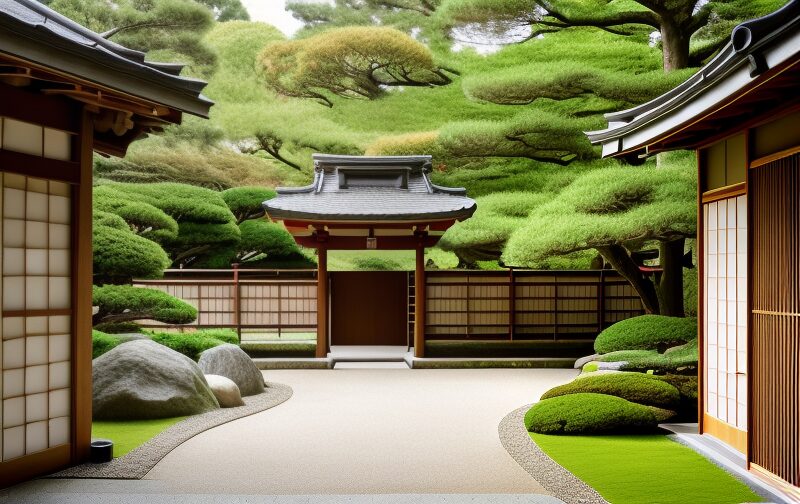Imagine strolling through the tranquil paths of a traditional Japanese garden, surrounded by lush greenery and delicate blossoms. As you wander, you come across a beautiful garden gate, intricately designed and adorned with symbols of cultural significance. In this article, we explore the role and significance of garden gates in Japanese gardens, uncovering the deeper meanings behind these architectural marvels. Discover how these gates act as portals between the physical and spiritual realms, and learn about the ancient customs and traditions they represent. Embark on a fascinating journey into the world of Japanese gardens and gain a newfound appreciation for the allure of their captivating entranceways.
Historical Background
Origins of Japanese Gardens
Japanese gardens have a rich history that dates back centuries. The origins of these serene spaces can be traced back to the Asuka period (538-710 AD), during which Japan adopted many cultural influences from China and Korea. The design and elements of Japanese gardens were heavily influenced by Buddhist and Taoist philosophies, with an emphasis on harmony between humans and nature.
Evolution of Garden Gates in Japanese Gardens
Garden gates have always played an important role in Japanese garden design. In ancient times, they served as demarcations of sacred spaces and were often found in the entrances of shrines and temples. Over time, the design and symbolism of garden gates evolved to represent not only a physical entrance but also a transition from the outside world into a contemplative and spiritual realm.
Aesthetics and Symbolism of Garden Gates
In Japanese gardens, aesthetics and symbolism go hand in hand, and garden gates are no exception. These gates are meticulously designed to create a harmonious and balanced atmosphere. They often feature intricate woodwork, ornate carvings, and beautiful roof structures known as “karamon” or “yagura-mon.” The symbolism behind garden gates is multifaceted, representing concepts such as transition, passage, welcoming, and the connection between the natural and the spiritual worlds.
Design and Structure
Traditional Design Elements
Japanese garden gates are known for their traditional design elements that have been passed down through generations. These include torii gates, lanterns, stone paths, and water features. Each element is strategically placed to create a sense of balance and harmony. Whether it’s the graceful curve of a roof or the placement of a stone lantern, these design elements work together to create a visually pleasing and spiritually inspiring space.
Materials Used in Garden Gates
The traditional materials used in Japanese garden gates have remained largely unchanged over the centuries. Wood is the primary material, often chosen for its natural beauty and versatility. Cedar and cypress are commonly used due to their durability and resistance to decay. In addition to wood, stone is also used to construct the foundation and steps of garden gates, symbolizing stability and longevity.
Features and Components of Garden Gates
Japanese garden gates are comprised of various features and components that contribute to their unique allure. Torii gates, for example, are commonly seen at the entrance of Shinto shrines and symbolize the transition from the everyday world to the sacred realm. Lanterns, on the other hand, add an ethereal glow to the garden at night, illuminating the path and creating a serene ambiance. Each component serves a purpose, whether it’s practical or symbolic, and adds to the overall aesthetic and atmosphere of the garden.

Entrance/Gate Types
Mon Gate
Mon gate is one of the most common types of garden gates in Japanese gardens. These gates are often lavish and extravagant, featuring intricate woodwork and exquisite decorations. Mon gates were traditionally used to mark the entrances of castles, temples, and palaces, symbolizing the status and importance of the structure beyond.
Karamon
Karamon, also known as “Chinese gate,” is a type of Japanese gate that is characterized by its intricate wooden carvings. These gates were heavily influenced by Chinese architecture and are often found in temple complexes. Karamon gates are a testament to the highly skilled craftsmanship of Japanese artisans, as the intricate carvings depict mythological creatures, flowers, and other ornate designs.
Yagura-mon
Yagura-mon gates are unique to Japanese gardens and add a touch of elegance and refinement. These gates consist of a simple wooden structure with a curved roof, creating a sense of tranquility and serenity. Yagura-mon gates are often found within the garden itself, leading to secluded areas or tea houses. Their design blends seamlessly with the natural surroundings, further enhancing the overall aesthetic appeal.
Taikomon
Taikomon, or “drum gate,” is a majestic type of gate commonly found in temples and shrines. This gate is characterized by its towering presence and grandeur. The roof of a taikomon gate resembles the shape of a drum, hence its name. Taikomon gates serve as a symbol of power and authority, evoking a sense of awe and reverence in those who pass through.
Niomon
Niomon gates, also known as “two-guardian” gates, are characterized by their striking symmetry and imposing presence. These gates are usually found at the entrance of Buddhist temples. Niomon gates typically feature two large wooden statues known as Nio, which are considered guardians of the Buddhist faith. The statues and the gate itself serve as protection and a reminder of the spiritual significance of the temple.
Functionality and Practicality
Security and Privacy
Garden gates in Japanese gardens serve practical purposes, such as security and privacy. In ancient times, these gates acted as a means to control access to sacred spaces, ensuring that only those with permission could enter. Today, garden gates offer a sense of privacy and seclusion, allowing visitors to relax and escape the outside world.
Boundary Establishment
Another important function of garden gates is to establish boundaries within the garden. These gates mark the transition from one area to another, creating a sense of progression and guiding visitors through the landscape. The boundaries set by garden gates act as a physical dividing line, separating different areas with distinct features and motifs.
Access Control
Garden gates also serve as a means of access control, ensuring that visitors follow a designated path and experience the garden in a specific order. By strategically placing gates in certain locations, garden designers can guide visitors on a curated journey through the garden, unveiling its beauty and symbolism in a deliberate sequence.

Cultural Significance
Reflecting Japanese Aesthetic and Philosophy
Japanese garden gates are a true reflection of the country’s aesthetic and philosophy. The meticulous craftsmanship and attention to detail exemplify the Japanese value of “wabi-sabi,” which embraces imperfection and finds beauty in simplicity. The carefully curated design elements and layout of garden gates embody the ideals of balance and harmony, creating an immersive and spiritually uplifting experience.
Zen Influence in Garden Gates
Zen Buddhism has had a profound influence on Japanese garden design, including the construction and symbolism of garden gates. Zen gardens are known for their minimalist and contemplative approach, and garden gates play an integral role in creating a sense of tranquility and mindfulness. The simple yet elegant design of Zen-inspired gates encourages visitors to let go of distractions and immerse themselves in the present moment.
Connection to Shintoism and Buddhism
Garden gates in Japanese gardens also hold religious and spiritual significance. Shintoism, with its reverence for nature and spirits, often incorporates gate-like structures known as “torii” in its sacred spaces. These torii gates symbolize the transition from the profane to the sacred and are commonly seen at the entrance of Shinto shrines. Similarly, Buddhist temples feature gates and entrances as a symbolic threshold between the physical world and the realm of enlightenment.
Symbolism and Meaning
Welcoming and Inviting
Garden gates in Japanese gardens are designed to evoke a sense of welcome and invitation. The grandeur and beauty of the gates are meant to entice visitors to enter and discover the serene ambiance that lies beyond. The careful placement of design elements such as lanterns and torii gates creates a visual pathway, guiding visitors deeper into the garden and inviting them to explore its hidden treasures.
Transition and Passage
Japanese garden gates symbolize the idea of transition and passage. As visitors pass through the gate, they leave behind the outside world and embark on a journey into a realm of tranquility and contemplation. The physical act of passing through a gate acts as a metaphorical transition from the ordinary to the extraordinary, marking a shift in mindset and allowing for a deeper connection with nature and oneself.
Promoting Serenity and Mindfulness
The symbolism of garden gates in Japanese gardens extends beyond the physical realm. These gates are designed to promote serenity and mindfulness, encouraging visitors to be present and appreciate the beauty of their surroundings. The deliberate placement of design elements, the gentle sound of flowing water, and the aromatic scent of surrounding plants all contribute to a sensory experience that fosters a peaceful state of mind.

Maintenance and Care
Cleaning and Repairing
To ensure the longevity and beauty of garden gates, regular cleaning and maintenance are essential. The wooden components of the gates should be periodically cleaned to remove dirt and debris, and any signs of decay or damage should be addressed promptly. Traditional techniques for cleaning and repairing wooden structures, such as sanding and reapplying protective coatings, can help preserve the gates for generations to come.
Preservation Techniques
Preservation techniques are crucial in maintaining the integrity of garden gates. The materials used, such as wood and stone, require special care to prevent deterioration. Applying wood preservatives and sealants can protect the gates from moisture and insects, while stone gates may benefit from regular cleaning and resealing to prevent staining and weathering.
Role of Traditional Techniques
Traditional techniques play a vital role in the preservation and maintenance of garden gates in Japanese gardens. The craftsmanship and knowledge passed down through generations help ensure that these gates remain true to their original design and withstand the test of time. Restorations and repairs often rely on traditional methods, such as joinery techniques and wood treatment, to maintain the authenticity and cultural significance of the gates.
Popular Japanese Gardens with Iconic Gates
Kinkaku-ji (Golden Pavilion) in Kyoto
The Kinkaku-ji, also known as the Golden Pavilion, is one of Japan’s most iconic landmarks. The garden surrounding the pavilion features a magnificent gate known as the Sekkari-mon, which serves as the entrance to the temple complex. The gate, adorned with intricate carvings and gold leaf, sets the tone for the breathtaking beauty that awaits within.
Kenroku-en in Kanazawa
Kenroku-en in Kanazawa is one of Japan’s three most beautiful gardens, known for its meticulous design and stunning scenery. The garden’s entrance features a traditional torii gate and stone pathway, inviting visitors to explore the meticulously manicured landscapes and scenic ponds. The gate serves as a visual transition, guiding visitors from the outside world into a realm of peace and tranquility.
Ryoan-ji (Zen Rock Garden) in Kyoto
Ryoan-ji is a Zen temple renowned for its rock garden, a UNESCO World Heritage site. The entrance to the temple complex is marked by a beautiful wooden gate known as the Taikomon. This grand gate, with its imposing presence and intricate design, prepares visitors for the Zen experience that awaits within the tranquil rock garden. It serves as a physical and symbolic gateway to the contemplative world of Zen Buddhism.
Contemporary Garden Gates
Modern Interpretations
In contemporary Japanese gardens, garden gates have evolved to incorporate modern interpretations while still honoring traditional design principles. These modern interpretations often blend elements of minimalism and functionality, emphasizing clean lines and natural materials. Contemporary garden gates may feature sleek metal structures or innovative combinations of stone and wood, demonstrating a harmonious coexistence between traditional and modern design aesthetics.
Incorporation of Western Elements
With the increasing global interaction and influence, Japanese gardens have also embraced the incorporation of Western elements into their design, including garden gates. These gates may incorporate Western architectural styles or materials while maintaining the fundamental principles of balance and harmony that are characteristic of Japanese aesthetics.
Integration with Landscape Architecture
Garden gates in Japanese gardens now often integrate with landscape architecture, creating a seamless connection between the built environment and the natural surroundings. The placement of gates is carefully considered to enhance the overall landscape design and to maximize the beauty and functionality of the garden. This integration allows garden gates to serve as both a functional entrance and a visually striking design element.
Conclusion
Garden gates in Japanese gardens serve both practical and symbolic purposes, acting as physical transitions and spiritual thresholds. With their intricate designs, traditional craftsmanship, and cultural significance, these gates remain an integral part of Japanese garden design. As they continue to evolve and adapt to contemporary styles, garden gates in Japanese gardens will always be a testament to the beauty and harmony of the Japanese aesthetic.








